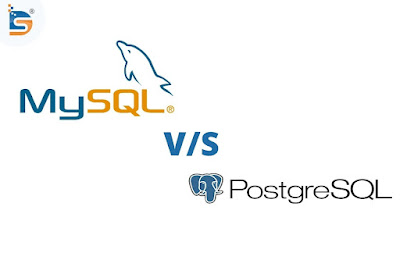The Key Differences Between PostgreSQL & MySQL
We'll look at two open-source database management systems in this article: MySQL and PostgreSQL. Where MySQL is an Oracle Corporation product and PostgreSQL is a Global Development Group product. Which one is the most appropriate to use? This question's response differs from programmer to coder. This is determined by the needs of the application or website that a programmer is developing.
The crucial PostgreSQL vs MySQL choice is based on the several use scenarios in which one might outperform the other. To put this into perspective, PostgreSQL is a feature-rich database that can perform complicated queries, whereas MySQL is a much simpler database that is considerably easier to set up and operate, as well as being fast, dependable, and simple to grasp.
MySQL, according to developers, is feature-light so it can focus on fast speed and dependability, making it ideal for websites and online transactions, but PostgreSQL is better for more complex analytical procedures.
All of these viewpoints, as well as others, are correct. Even while new versions continue to close the gap between PostgreSQL and MySQL, this article discusses a few key distinctions between the two, allowing you to make an informed choice between the two based on your needs.
What is MySQL?
MySQL is an open-source database platform as well, but it is a large-scale database, one that is widely used, and one that is also the most trusted. Oracle backs MySQL, and it has a lot of third-party tool support (a few of the tools which can be thought of are MySQL Workbench, dbForge Studio, etc.).
It is a well-known open-source relational database management system (RDMS). The data in this table is stored in tables, making CRUD operations simple (Create, Read, Update and Delete).
History of MySQL
MySQL was founded in 1995 by MySQL AB, a Swedish business.
In 2008, Sun paid one billion dollars for MySQL AB.
In 2010, Oracle purchased Sun, which included MySQL.
In 2012, founder Michael Widenius split MySQL into MariaDB under the firm Monty Program Ab.
In 2013, MariaDB will mostly replace MySQL in most distributions.
Monty Program Ab and SkySQL merged in 2013
In 2014, SkySQL Ab was renamed MariaDB Corporation.
Why use MySQL?
Some compelling reasons to use MYSQL include the following:
Supports Master-Slave Replication and Scale-Out
It provides Offload Reporting, Geographic Data Distribution, and other features.
MyISAM storage engine has a very low overhead when used for read-only applications.
Memory storage engine support for frequently used tables
Query Cache for Statements That Are Used Frequently
You can easily learn and troubleshoot MySQL from various sources such as blogs, white papers, and books.
What Kinds of Applications Exist in MySQL?
MySQL is a partially SQL-compliant database that is suitable for simple web applications or any application that requires a simple schema design and data operations performed using simple SQL queries. MySQL is not a good choice for complex applications that handle large amounts of data.
What is PostgreSQL?
PostgreSQL is well-known in the market for its ability to handle complex, high-volume data operations. When compared to other Database Management Systems, PostgreSQL has a few more features and is more extensible. It allows you to define index types, data types, and functional languages in addition to storing information in the form of tables and columns.
Postgre is a relational database system designed for enterprise use. It is simple to set up and install. It supports SQL and NoSQL databases. It has a fantastic community that is eager to assist you if you are having problems with PostgreSQL.
History of PostgreSQL
INGRES was created in 1977.
Postgres was created in 1986 by Michael Stonebraker and his colleagues.
Real ACID and PL/pgSQL support – 1990
Postgres95 was released in -1995.
Postgres95 was re-released as PostgreSQL 6.0 in 1996.
MVCC, GUC, Join Syntax Controls, and a Procedural Language Loader were added between 1998 and 2001.
Versions 7.2 to 8.2: Added Schema support, Non-Blocking VACUUM, Roles, and dblink – 2002-2006
PostgreSQL 8.4 was released in 2009.
In 2010, PostgreSQL 9.0 was released.
NYCPUG (New York City PostgreSQL User Group) becomes a member of PgUS (United States PostgreSQL Association) in 2013
PGconf organized in 2014
Why use PostgreSQL?
The following are the primary reasons for using PostgreSQL:
Provides useful features such as table partitioning, point-in-time recovery, transactional DDL, and so on.
Capability to use third-party Key Stores in a full PKI infrastructure
Because open-source code is licensed under BSD, developers can modify it without having to contribute back enhancements.
Independent Software Vendors (ISVs) can redistribute it without fear of being "infected" with an open-source license.
It is possible to assign users and roles. Object-level permissions
AES, 3DES, and other data encryption algorithms are supported.
What Kinds of Applications Exist in PostgreSQL?
PostgreSQL is an open-source database that is completely ACID compliant, enterprise-ready, and user-friendly for both developers and DBAs. PostgreSQL is the ideal solution for high-transactional and sophisticated applications in any area, and it can handle a wide range of web and mobile application services. PostgreSQL may also be used to conduct complex reporting queries and operations on massive amounts of data, making it an excellent data warehouse.




Comments
Post a Comment